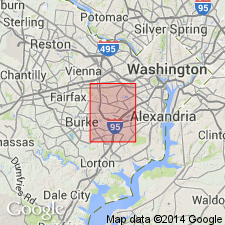
- Usage in publication:
-
- Station Hills Phyllite Member*
- Modifications:
-
- Named
- Dominant lithology:
-
- Phyllite
- AAPG geologic province:
-
- Piedmont-Blue Ridge province
Summary:
Light-greenish-gray, dusky-yellow weathering phyllite and lesser fine-grained metasiltstone occupying the core of the Popes Head synform in Fairfax Co., VA, is here named the Station Hills Phyllite Member of the Popes Head Formation. Conformably overlies the Old Mill Branch Member of the Popes Head. Maximum thickness is about 300 m, but the top of the unit is not exposed. Age is Late Proterozoic and (or) Early Cambrian, based on a radiometric age of Early Cambrian for the Occoquan Granite, which intrudes the Popes Head.
Source: GNU records (USGS DDS-6; Reston GNULEX).

- Usage in publication:
-
- Station Hills Phyllite Member*
- Modifications:
-
- Age modified
- AAPG geologic province:
-
- Piedmont-Blue Ridge province
Summary:
The age of the Popes Head Formation and its Old Mill Branch Metasiltstone and Station Hills Phyllite Members is now believed to be Cambrian because the Popes Head unconformably overlies the other lithotectonic units in the area, and is intruded by the Occoquan Granite, which may be as young as Late Cambrian, based on a Sr-Rb age of 494+/-14 Ma.
Source: GNU records (USGS DDS-6; Reston GNULEX).

- Usage in publication:
-
- Station Hills Phyllite [Member]
- Modifications:
-
- Overview
- AAPG geologic province:
-
- Piedmont-Blue Ridge province
Summary:
Popes Head Formation is divided on the State map into Station Hills Phyllite and Old Mill Branch Metasiltstone [Members]. The Popes Head unconformably overlies the Mather Gorge, Sykesville, and Yorkshire Formations, the Annandale Group, and the Piney Branch Complex. Old Mill Branch is intruded by the Occoquan granite, which has been dated at 479+/-9 Ma by J.N. Aleinikoff (1993, written commun., U-Pb single-crystal zircon). Map symbol indicates that age of Station Hills is considered Cambrian and Ordovician.
Source: GNU records (USGS DDS-6; Reston GNULEX).
For more information, please contact Nancy Stamm, Geologic Names Committee Secretary.
Asterisk (*) indicates published by U.S. Geological Survey authors.
"No current usage" (†) implies that a name has been abandoned or has fallen into disuse. Former usage and, if known, replacement name given in parentheses ( ).
Slash (/) indicates name conflicts with nomenclatural guidelines (CSN, 1933; ACSN, 1961, 1970; NACSN, 1983, 2005, 2021). May be explained within brackets ([ ]).

